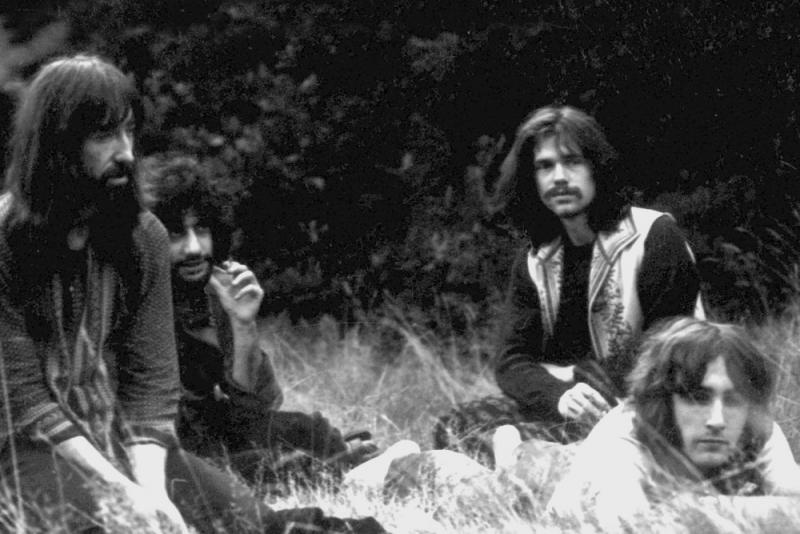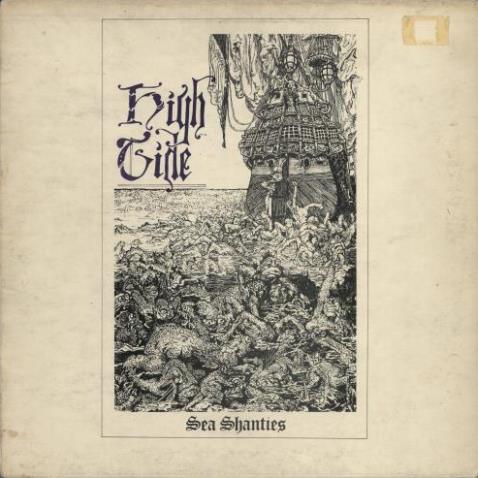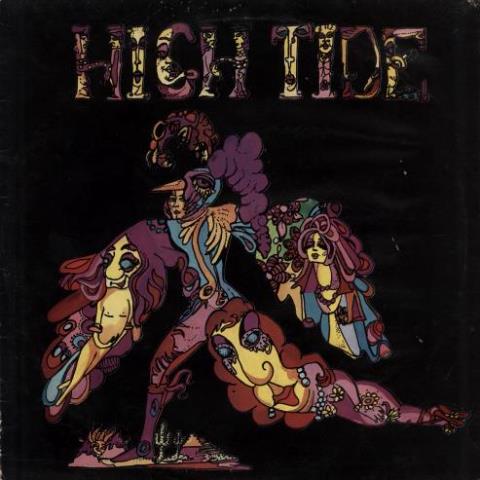Music Reissues Weekly: High Tide - The Complete Liberty Recordings | reviews, news & interviews
Music Reissues Weekly: High Tide - The Complete Liberty Recordings
Music Reissues Weekly: High Tide - The Complete Liberty Recordings
Heavy, dark and relentless music from the London underground of 1969 and 1970

High Tide were one of many late Sixties and early Seventies British bands unearthed in the early Eighties by record collectors digging into what came after psychedelia. The bands didn’t have similar musical styles but were united by their obscurity and having sold barely any copies of their albums. All were largely forgotten until their rediscovery. Ben, Gracious!, Pussy, Red Dirt, T2, more. Who were these bands? Who were High Tide?
As is the way, collector interest and the sharply rising prices of original pressings resulted in digging for information and reissues. High Tide had released two albums: December 1969’s Sea Shanties and July 1970’s High Tide. They were on Liberty, as was Hawkwind’s first LP. Their violinist, Simon House, later joined Hawkwind and toured with David Bowie. Their guitarist Tony Hill had been the sole Brit in transplanted, London-based Californian psychedelic band The Misunderstood. High Tide slotted into known territories.
 Limited-edition reissues of Sea Shanties and High Tide appeared in 1982. Next, bootleg versions of both surfaced in 1984. The interest was there. Then, CD editions appeared in 1993 and 1994. A version of the band reappeared in 1990 and went on to make three albums, the last going on sale in 1991. A link with legendary-for-real freaks Rustic Hinge and the Provincial Swimmers was discovered. What had been subterranean had become almost – in record-nut terms – mainstream. Now, the original High Tide albums sell for anywhere between £100 and £500.
Limited-edition reissues of Sea Shanties and High Tide appeared in 1982. Next, bootleg versions of both surfaced in 1984. The interest was there. Then, CD editions appeared in 1993 and 1994. A version of the band reappeared in 1990 and went on to make three albums, the last going on sale in 1991. A link with legendary-for-real freaks Rustic Hinge and the Provincial Swimmers was discovered. What had been subterranean had become almost – in record-nut terms – mainstream. Now, the original High Tide albums sell for anywhere between £100 and £500.
It’s handy then that The Complete Liberty Recordings includes everything they recorded under their own name during their original 1969 to 1970 lifespan for a keen selling price of around £23. The small, smart box set with a lift-off lid contains three CDs, a booklet and a repro of a poster. Disc One is Sea Shanties; Disc Two is High Tide with a bonus track that wasn’t issued at the time; Disc Three collects more tracks unreleased when the band was going, but were later disinterred for archive albums and bonuses for previous reissues of the two albums. This one-stop box set doesn’t tell a new story but it is the neatest, most coherent summation of High Tide so far.
 High Tide were Tony Hill (guitar, vocals), Simon House (violin), Roger Hadden (drums) and Peter Pavli (bass). The band formed in early 1969 after the post-Misunderstood Hill spent September to November 1968 in the trio Turquoise, with David Bowie and Hermione Farthingale. They played The Roundhouse but Hill left, wanting to do his own thing. The link with Pavli was made through music biz mover Ian Samwell, who Hill knew. In turn, Simon House knew Pavli: he was originally a bass player but slotted in to the new band on violin. The nascent band’s first manager found drummer Hadden, who worked for Liberty Records.
High Tide were Tony Hill (guitar, vocals), Simon House (violin), Roger Hadden (drums) and Peter Pavli (bass). The band formed in early 1969 after the post-Misunderstood Hill spent September to November 1968 in the trio Turquoise, with David Bowie and Hermione Farthingale. They played The Roundhouse but Hill left, wanting to do his own thing. The link with Pavli was made through music biz mover Ian Samwell, who Hill knew. In turn, Simon House knew Pavli: he was originally a bass player but slotted in to the new band on violin. The nascent band’s first manager found drummer Hadden, who worked for Liberty Records.
The well-connected quartet’s first job was as the backing band on an album by Denver Gerrard, titled Sinister Morning. As High Tide, they soon attracted interest and, in March 1969, recorded three tracks as demos for The Beatles’ Apple Publishing (heard on Disc Three). They then signed with Liberty, who had just had some success The Groundhogs, their roster's first undergound-ish band High Tide were also picked up by management company Clearwater Productions, which had Cochise, Skin Alley and Trees on their books. A little later, Clearwater also took on Hawkwind. It was all going swimmingly. High Tide were set up to become underground favourites. However, neither of their LPs sold well and after recording one demo for a third (“Ice Age,” heard on Disc Three), Liberty let them go. By the end of 1970, they had split.
 Sea Shanties and, to a lesser extent as it’s less focussed, High Tide explain the belated interest. The six-track Sea Shanties opens with “Futilist’s Lament.” It’s heavy, dark and relentless. Forbidding. There’s a hint of “White Room” Cream but this track is so hard its controls are set for the void. Hill riffs on his guitar but really seems to be interested in playing a long, distorted solo. House’s eerie violin snakes in and out of the cacophony. On the rest of the album, only the folky “Walking Down Their Outlook” and the similarly folk-tinged final track “Nowhere” – think Unhalfbricking Fairport Convention with a bad headache had they taken inspiration from Led Zep’s “Dazed and Confused” – are less severe.
Sea Shanties and, to a lesser extent as it’s less focussed, High Tide explain the belated interest. The six-track Sea Shanties opens with “Futilist’s Lament.” It’s heavy, dark and relentless. Forbidding. There’s a hint of “White Room” Cream but this track is so hard its controls are set for the void. Hill riffs on his guitar but really seems to be interested in playing a long, distorted solo. House’s eerie violin snakes in and out of the cacophony. On the rest of the album, only the folky “Walking Down Their Outlook” and the similarly folk-tinged final track “Nowhere” – think Unhalfbricking Fairport Convention with a bad headache had they taken inspiration from Led Zep’s “Dazed and Confused” – are less severe.
On High Tide (pictured above right), there are just three tracks: two on what was Side One of the album and one on Side Two. Opener “Blankman Cries Again” takes this Cream, Fairports, heavier-than-heavy approach, while “The Joke” edges towards Traffic – albeit without sacrificing High Tide’s characteristic ferocity. Side Two's “Saneonymous” is a 14-and-a-half-minute portmanteau piece which, in part, showcases High Tide at their most measured. The sections consisting of amorphous instrumental workouts in difficult time signatures are hard to deal with though.
And with the end of “Saneonymous,” that was it on record for High Tide. Until, that is, the record collectors came digging. The legacy compiled by The Complete Liberty Recordings is idiosyncratic, uncompromising and, despite the apparent influences, sounds unlike anything else. High Tide were doing their own thing. Doubtless, in large part, this is why they have so strong a posthumous reputation.
- Next week: Soft Cell’s first LP Non-Stop Erotic Cabaret becomes a box set
- More reissue reviews on theartsdesk
- Kieron Tyler’s website
Explore topics
Share this article
more New music
 Album: Justice - Hyperdrama
French electronic dance stalwarts return from eight-year break in fine fettle
Album: Justice - Hyperdrama
French electronic dance stalwarts return from eight-year break in fine fettle
 Album: St Vincent - All Born Screaming
Annie Clark transcends indie’s average leanings
Album: St Vincent - All Born Screaming
Annie Clark transcends indie’s average leanings
 Album: Pet Shop Boys - Nonetheless
Longing, love and longevity as the duo resolutely refuse retirement
Album: Pet Shop Boys - Nonetheless
Longing, love and longevity as the duo resolutely refuse retirement
 Album: Mdou Moctar - Funeral for Justice
Tuareg rockers are on fiery form
Album: Mdou Moctar - Funeral for Justice
Tuareg rockers are on fiery form
 Album: Fred Hersch - Silent, Listening
A 'nocturnal' album - or is it just plain dark?
Album: Fred Hersch - Silent, Listening
A 'nocturnal' album - or is it just plain dark?
 Music Reissues Weekly: Linda Smith - I So Liked Spring, Nothing Else Matters
The reappearance of two obscure - and great - albums by the American musical auteur
Music Reissues Weekly: Linda Smith - I So Liked Spring, Nothing Else Matters
The reappearance of two obscure - and great - albums by the American musical auteur
 The Songs of Joni Mitchell, Roundhouse review - fans (old and new) toast to an icon of our age
A stellar line up of artists reimagine some of Mitchell’s most magnificent works
The Songs of Joni Mitchell, Roundhouse review - fans (old and new) toast to an icon of our age
A stellar line up of artists reimagine some of Mitchell’s most magnificent works
 Album: Taylor Swift - The Tortured Poets Department: The Anthology
Taylor Swift bares her soul with a 31-track double album
Album: Taylor Swift - The Tortured Poets Department: The Anthology
Taylor Swift bares her soul with a 31-track double album
 theartsdesk on Vinyl: Record Store Day Special 2024
Annual edition checking out records exclusively available on this year's Record Store Day
theartsdesk on Vinyl: Record Store Day Special 2024
Annual edition checking out records exclusively available on this year's Record Store Day
 Album: Jonny Drop • Andrew Ashong - The Puzzle Dust
Bottled sunshine from a Brit soul-jazz team-up
Album: Jonny Drop • Andrew Ashong - The Puzzle Dust
Bottled sunshine from a Brit soul-jazz team-up
 Album: Pearl Jam - Dark Matter
Enduring grunge icons return full of energy, arguably their most empowered yet
Album: Pearl Jam - Dark Matter
Enduring grunge icons return full of energy, arguably their most empowered yet
 Album: Paraorchestra with Brett Anderson and Charles Hazlewood - Death Songbook
An uneven voyage into darkness
Album: Paraorchestra with Brett Anderson and Charles Hazlewood - Death Songbook
An uneven voyage into darkness

Add comment